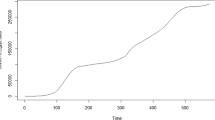Abstract
The COVID-19 pandemic has been spreading and affecting worldwide. On 30th January 2020 India reported its first coronavirus confirmed case. The main aim of the proposed work is to devise an algorithm for prediction of Covid-19 cases in India. In this paper, we propose to use time-series algorithms, Autoregressive Integrated Moving Average (ARIMA) and Autoregressive (AR). We have simulated the designed algorithm with the dataset of COVID-19 till 20th February, 2021 for the wave1 and from 01st March, 2021 till 25th September, 2021 we collected data for wave2 and generated 6-days forecasts of confirmed, recovered and death cases. During the 1st wave we observed that there might be another wave 2, after analyzing the wave1 dataset, of coronavirus as result shows that Covid-19 confirmed cases are rising rapidly. Proposed research observations show that the death rate is decreasing, and recovery rate is increasing, one of the possible reasons is herd immunity and vaccination. We are comparing actual cases with forecasting coronavirus cases. ARIMA based models are showing promising results over AR based models. The most difficult part doing this work is to identify parameters due to sudden increase-decrease trend in coronavirus cases. The proposed work reports quality scoring metrics of forecasting for both the models. This will help future researchers to find the best outcome among Auto Regressive Integrated Moving Average (ARIMA) and Auto Regressive (AR) based models.
Access this chapter
Tax calculation will be finalised at checkout
Purchases are for personal use only
Similar content being viewed by others
References
Home. https://www.who.int
MoHFW | Home. https://www.mohfw.gov.in/
Coronavirus in India: Latest Map and Case Count. https://www.covid19india.org/
COVID19-India API. https://api.covid19india.org/
Coronavirus Data, Insights & Trends (Covid-19) – SimilarWeb. https://www.similarweb.com/coronavirus/
Attaluri, P., Chen, Z., Lu, G.: Applying neural networks to classify influenza virus antigenic types and hosts. In: 2010 IEEE Symposium on Computational Intelligence in Bioinformatics and Computational Biology (2010)
Youwen, L., Haihong, J., Jianjun, H.: Identification of four goatpox virus outbreaks in Xinjiang of China in 2010. In: Proceedings 2011 International Conference on Human Health and Biomedical Engineering (2011)
Kim, E., Lee, S., Kim, J., Byun, Y., Lee, H., Lee, T.: Implementation of novel model based on genetic algorithm and TSP for path prediction of pandemic. In: 2013 International Conference on Computing, Management and Telecommunications (ComManTel) (2013)
Rani, P., Raychoudhury, V., Sandha, S., Patel, D.: Mobile health application for early disease outbreak-period detection. In: 2014 IEEE 16th International Conference on e-Health Networking, Applications and Services (Healthcom) (2014)
Chowdhury, B., Chowdhury, M., Sultana, N.: Real-time early infectious outbreak detection systems using emerging technologies. In: 2009 International Conference on Advances in Recent Technologies in Communication and Computing (2009)
Zhang, Y., Cheung, W., Liu, J.: A Unified Framework for epidemic prediction based on poisson regression. IEEE Trans. Knowl. Data Eng. 27, 2878–2892 (2015)
Park, J., Jang, J., Ahn, I.: Epidemic simulation of H1N1 influenza virus using GIS in South Korea. In: 2017 International Conference on Information and Communication Technology Convergence (ICTC) (2017)
Chen, T., Chen, Y., Chen, J., Chang, F.: Flu trend prediction based on massive data analysis. In: 2018 IEEE 3rd International Conference on Cloud Computing and Big Data Analysis (ICCCBDA) (2018)
Balasundaram, A., Bhuvaneswari, P.: Comparative study on decision tree based data mining algorithm to assess risk of epidemic. In: IET Chennai Fourth International Conference on Sustainable Energy and Intelligent Systems (SEISCON 2013) (2013)
Mishra, V., Tiwari, N., Ajaymon, S.: Dengue disease spread prediction using twofold linear regression. In: 2019 IEEE 9th International Conference on Advanced Computing (IACC) (2019)
Zhong, L., Mu, L., Li, J., Wang, J., Yin, Z., Liu, D.: Early prediction of the 2019 novel coronavirus outbreak in the mainland china based on simple mathematical model. IEEE Access. 8, 51761–51769 (2020)
Ribeiro, M., da Silva, R., Mariani, V., Coelho, L.: Short-term forecasting COVID-19 cumulative confirmed cases: perspectives for Brazil. Chaos Solit. Fractals 135, 109853 (2020)
Ghazaly, N., Abdel-Fattah, M., Aziz, A.: Novel coronavirus forecasting model using nonlinear autoregressive artificial neural network. Int. J. Adv. Sci. Technol. 29, 1831–1849 (2020)
Rao, J., Box, G., Jenkins, G.: Time series analysis forecasting and control. Econometrica 40, 970 (1972)
Gupta, V., Gupta, A., Kumar, D., Sardana, A.: Prediction of COVID-19 confirmed, death, and cured cases in India using random forest model. Big Data Min. Anal. 4, 116–123 (2021)
Parbat, D., Chakraborty, M.: A Python based support vector regression model for prediction of COVID19 cases in India. SSRN Electron. J., 1831–1849 (2020)
Jarndal, A., Husain, S., Zaatar, O., Gumaei, T., Hamadeh, A.: GPR and ANN based prediction models for COVID-19 death cases (2021)
Author information
Authors and Affiliations
Corresponding authors
Editor information
Editors and Affiliations
Rights and permissions
Copyright information
© 2022 The Author(s), under exclusive license to Springer Nature Switzerland AG
About this paper
Cite this paper
Prajapati, D., Kanojia, M. (2022). Forecasting of COVID-19 Cases in INDIA Using ARIMA and AR Time-Series Algorithm. In: Abraham, A., et al. Proceedings of the 13th International Conference on Soft Computing and Pattern Recognition (SoCPaR 2021). SoCPaR 2021. Lecture Notes in Networks and Systems, vol 417. Springer, Cham. https://doi.org/10.1007/978-3-030-96302-6_33
Download citation
DOI: https://doi.org/10.1007/978-3-030-96302-6_33
Published:
Publisher Name: Springer, Cham
Print ISBN: 978-3-030-96301-9
Online ISBN: 978-3-030-96302-6
eBook Packages: Intelligent Technologies and RoboticsIntelligent Technologies and Robotics (R0)




